I grew up in central Massachusetts, and still live there. When I was a kid, each summer my family rented the same beach cottage near the east end of the Cape Cod Canal. It was there that my love of saltwater fishing began. Around 1990, intrigued by having seen a fellow using a fly rod on the beach during one of my saltwater spin-fishing outings, I started fly-fishing in the salt, working Cape Cod waters from shore. As it is with most shorebound anglers, thoughts about buying a boat were inevitable, but I lived two hours from the Cape and had a young family, so I couldn’t justify the expense. To get a taste of what it might be like to have access to all that water beyond the reach of my best cast, I hired Cape Cod saltwater fly-fishing guide Capt. Bob McAdams.
On the day of the charter, Bob had me meet him at a town landing on Nauset Marsh in Eastham on the lower Cape. His boat was a sharp-looking 16′ open wooden skiff with a tiller-steered 30-hp outboard. The skiff had been custom built by Walter Baron of Old Wharf Dory in the neighboring town of Wellfleet. At first glance, I was a bit concerned about the boat’s stability as both Bob and I were each over 200 lbs, but I climbed aboard and sat facing forward on the wide amidships thwart. As we got underway, the boat skimmed beautifully through the marsh, and it wasn’t long before we got to our fishing spot. When I stood and started to swing the fly rod for my first cast, my concerns about stability quickly dissipated. We caught several fish, and I was really impressed with the skiff as a fly-fishing platform.
 Walter Baron
Walter BaronOn flat water, the 30-hp outboard pushes the skiff along nicely at 25 mph.
That was in 1994. I continued to fly-fish from shore on the Cape whenever I could, sometimes even stealing time from my forestry consulting business. I help woodland owners manage their forests for healthy, sustainable timber growth, and since I love working with wood in its natural environment, it occurred to me that any boat I was ever going to own should be made of wood. I didn’t have the skills, time, or tools to build one myself, so I looked up and contacted Walter Baron, the builder of Bob’s boat, and learned that he had dubbed the design, appropriately enough, the Nauset Marsh Skiff.
I had found my boatbuilder, but another 10 years passed as my wife and I got our kids through college and out on their own. By then, building my dream skiff had moved to the top of my bucket list and I had several conversations with Walter, as well as a couple of visits at his shop to discuss a design. After years of dreaming about it, I knew exactly what I wanted in a saltwater fly-fishing skiff. It would be around 16’ and easy to trailer, launch, and retrieve by myself with a flat bottom so I could run in the shallows and beach it upright. I wanted raised casting decks fore and aft with storage below them, and economical outboard power with speed capability around 20 to 25 mph.
After exploring a number of traditional and plywood designs, we eventually circled back to the boat that had so impressed me originally, the Nauset Marsh Skiff, and Walter began construction of mine in January 2014. Five months later we launched the finished boat.
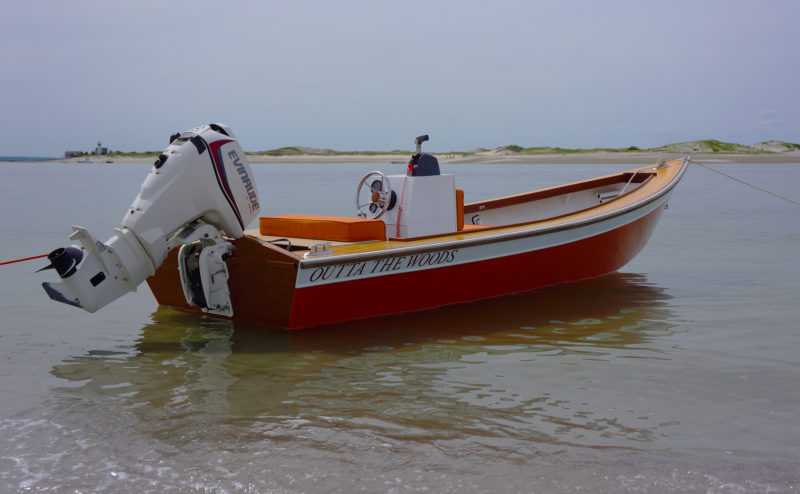 Erik Brandstaedter
Erik BrandstaedterThe hull draws just 6″. With the motor down, the skiff needs at least 12″ of water.
The skiff has stitch-and-glue plywood construction, with the exterior sheathed in fiberglass cloth set in epoxy. The flared 3/8″ okoume topsides and the transom—a sandwich of a 3/4″ cedar core glued between layers of 3/8″ sapele marine plywood—are joined to a flat, narrow, 1/2″ fir marine plywood bottom. Assembled, these initial elements immediately revealed the pleasing lines of the boat, highlighted by a gentle, upswept sheer forward and 5″ of rocker along the bottom. The greatest beam, measuring 66″, is just forward of the stern to support the weight of a 25- or 30-hp outboard. I went with the 30 hp Evinrude E-Tec—at 150 lbs, it is no heavier than the 25 hp.
I wanted to pilot the skiff from as far aft as was practical to accommodate a large, raised, fly-fishing-friendly, forward casting deck, but still leave enough room for a smaller, raised casting deck in the stern. I abandoned the cost-saving consideration of tiller steering in favor of a small center console, with power tilt and trim controls on the motor for comfort, and ease of operation. I also wanted to be able to stand comfortably at the helm while underway without having to bend over to grasp the wheel or throttle. To that end, Walter made a cardboard mock-up of the console and had me down to the shop for a couple of fittings to get the height just right.
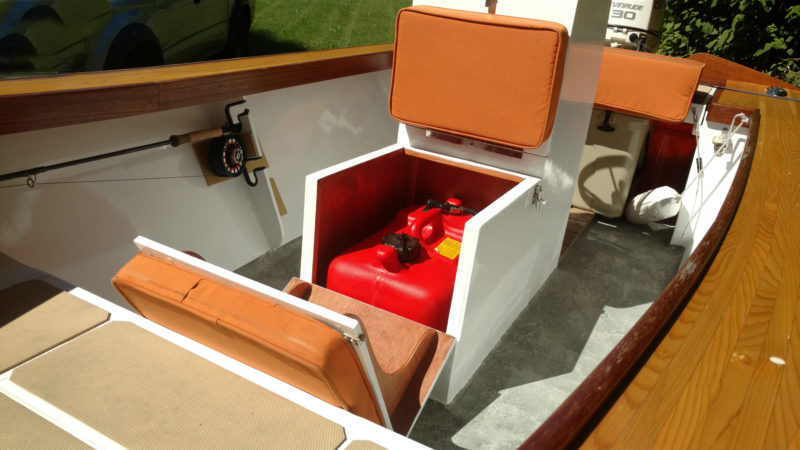 Craig Masterman
Craig MastermanThe gas tank hides under the passenger seat at the front of the console. Having the weight of the fuel forward helps maintain proper trim.
One of the features I had seen and loved on a couple of Walter’s boats was the look of bright-finished cedar-strip side decks. Not only are they beautiful, but they add great strength and rigidity to the hull. On my skiff, as an added detail, Walter chose red balau, an Indonesian hardwood, for the outermost strip on the side decks, and for the coaming around the cockpit. Finished with Epifanes Rapid Clear for ease of application and maintenance, the results are stunning as the rich, dark reddish-brown color hardwood contrasts beautifully with the light color of the cedar.
Foam-filled flotation chambers in the bow, and in the port and starboard corners of the stern, sit just below the cedar-strip decking. The clear-varnished transom is the last of the brightwork. Except for the cockpit sole, which is painted with Skid-No-More, an acrylic coating textured with rubber particles, the remaining surfaces, inside and out, are finished with Epifanes two-part polyurethane paint for its high gloss and durability. The orange hull and white faux sheerstrake are a tribute to my late father-in-law, who built several small wooden boats over his lifetime, the last of which, wistfully named ONCE IN A WHILE, featured similar hull colors.
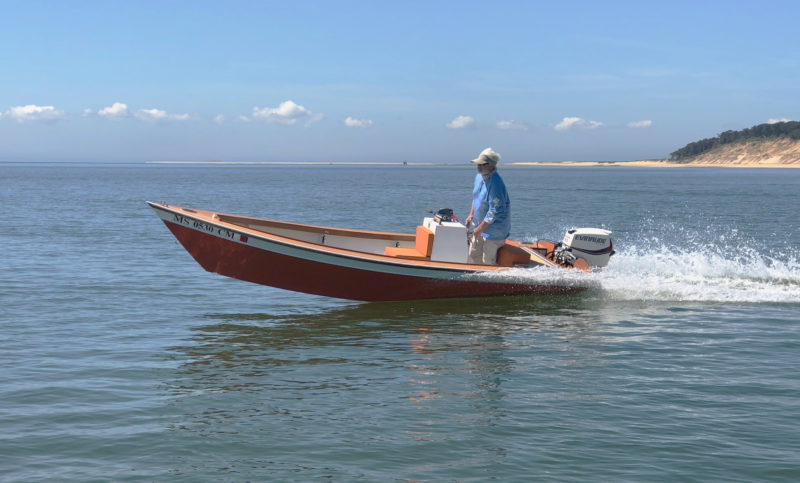 Walter Baron
Walter BaronPutting the helm over drives the inside chine down and the hull, now angled, carves through turns without skidding.
Since my boat lives on a trailer, we skipped bottom paint. SeaDek, a peel-and-stick nonskid foam, covers the front and rear casting decks. The battery and a 6-gallon portable fuel tank sit under the console and integrated passenger seat, respectively. To keep the rigging clean and out of the way, Walter made some removable cedar floor boards to cover the fuel line, steering, and battery cables between the console and the outboard.
The 30-hp motor moves the boat along at a GPS-measured 25-mph top speed. Like any flat-bottomed hull, it will pound in a chop at higher speeds. Because the helm and console are positioned well aft of the midpoint, I initially had some porpoising above 20 knots when I was alone in the boat; 50 lbs of ballast in the forward hatch eliminated that problem completely. If I throttle back in rough water, the 5″ rocker in the bottom allows the skiff to smoothly slither up and over moderate swells and boat wakes. Even without spray rails, the skiff is remarkably dry, as the flared sides deflect virtually all spray, in all conditions and at most speeds, save for a wind directly abeam, when some spray will inevitably find its way over the rails.
Two parallel 8′ long 1″x1″ bevel-sided, white-oak shoes running along the stern half of the bottom hold the boat where you point it. They’re positioned to slide between the trailer bunks to help align the skiff when hauling out. Sharp turns at speed bury the hard chine, and the skiff holds beautifully with little or no drift. It floats in about 6″ of water with the engine tilted up, and runs in about 12″.
The forward casting deck is very stable and comfortable to stand on and cast from. There is an anchor locker hatch forward and a larger second hatch for storage below the deck. The smaller aft casting deck is higher, and is fine to cast from in flat water, but is a little less secure in a light chop. The rear deck flips up to provide access to a 50-quart cooler. Fly-rod racks and tip tubes are tucked out of the way under the side decks in tubes—two forward and one aft—and offer secure storage for four 9′ fly rods both port and starboard. Pop-up cleats fold flush to eliminate fly line’s inadvertently catching on them.
The boat’s performance has met or exceeded all my expectations. It remains a source of great joy, pride, and satisfaction. The skiff turns heads and generates questions and complements wherever I go, and I am always proud to credit its builder for creating the piece of functional art that it is. People especially seem to like and appreciate the name my wife came up with, which ties together my personal history, my profession as a forester, and my gratitude for all the blessings of my life, not the least of which is this fine little craft named OUTTA THE WOODS.![]()
Craig Masterman, 65, has lived in central Massachusetts most of his life. He and Marjory, his wife of 42 years, have three grown children and a grandson. Craig has always appreciated the natural beauty of both trees and wood as a building material, stemming from his 40-year career as a forester. He plans to fish the flats and estuaries of southwest Florida as well as the inshore waters of Cape Cod as often as he can in his approaching retirement.
Nauset Marsh Skiff Particulars
[table]
Length/16′
Beam/66″
Bottom width/41″
Hull depth minimum/20.5″
Bow height/33″
Finished boat /450 lbs
Boat, rigging, and outboard/690 lbs
[/table]
Walter Baron, doing business as Old Wharf Dory in Wellfleet, Massachusetts, builds Nauset Marsh Skiffs.
Is there a boat you’d like to know more about? Have you built one that you think other Small Boats Monthly readers would enjoy? Please email us!
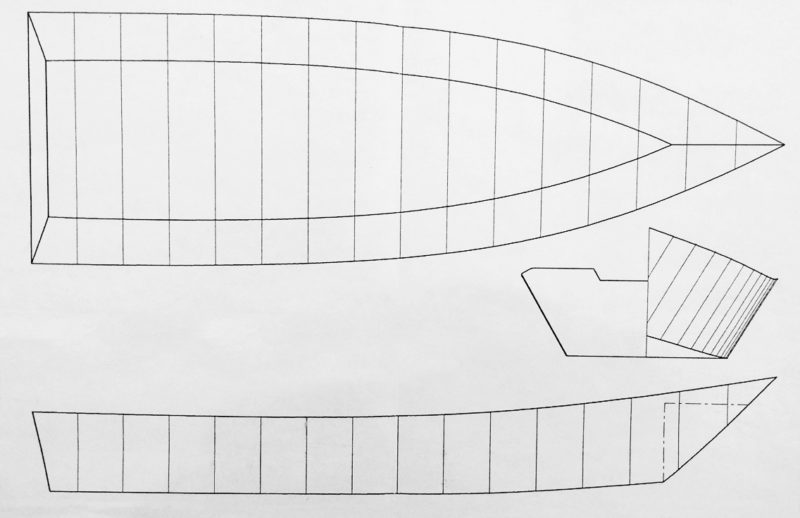
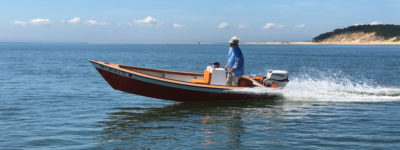
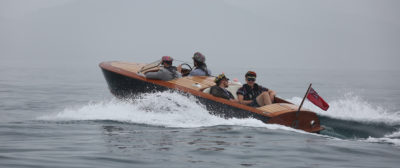
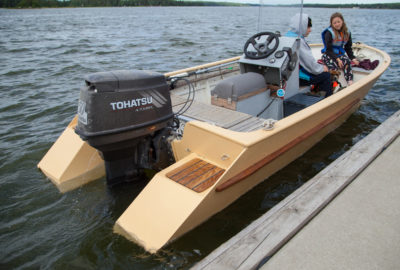
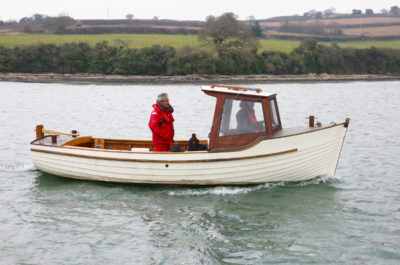
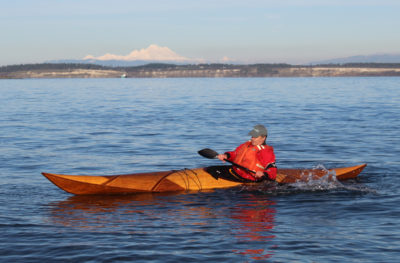
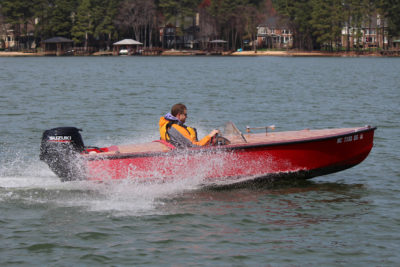
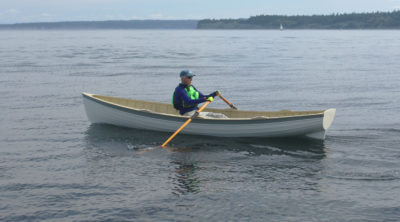
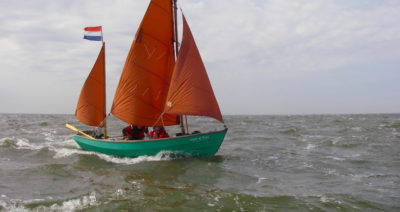
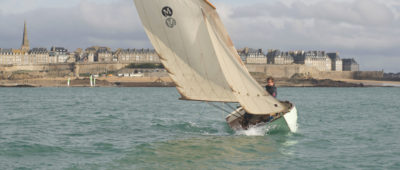
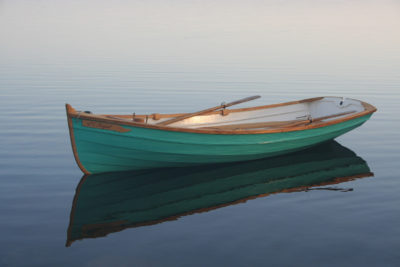
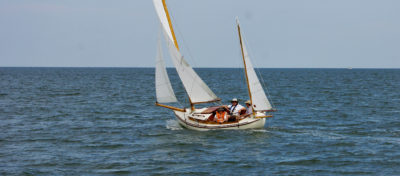
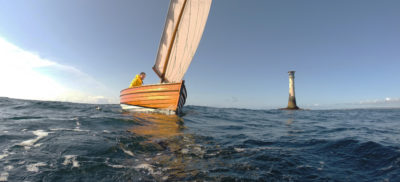
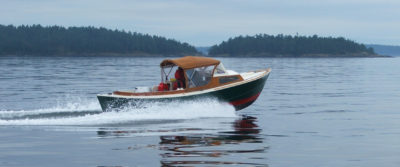

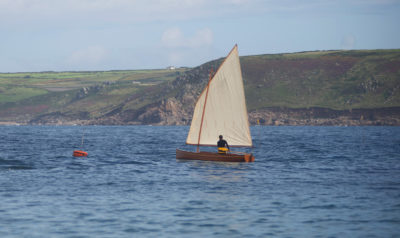
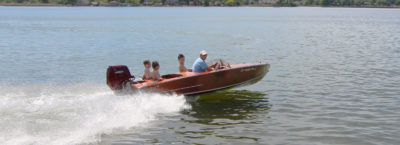
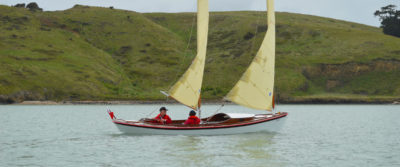
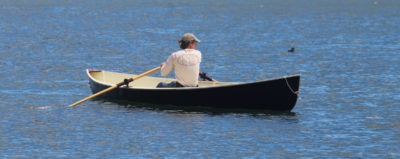
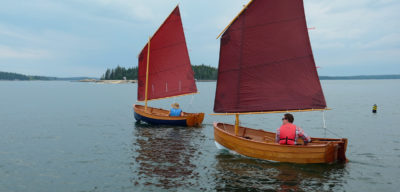

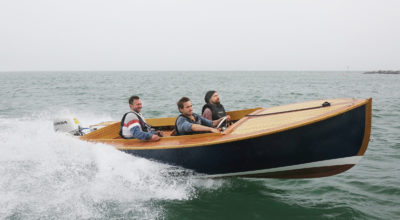
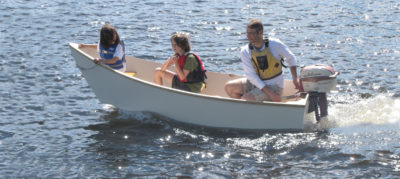
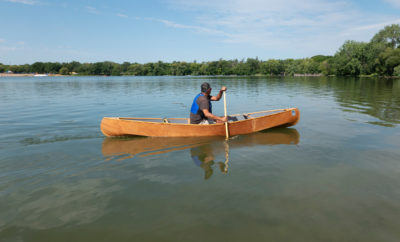
What a beautifully written article! I enjoyed it very much.
Mary Helen Dick
(Sister-in-law to author Craig Masterman as the sister to his wife, Marjory)
It appeared in the video that the boat had a problem with “porpoising” as the water was fairly calm. How would you stop that when piloting solo? Maybe it always needs someone in the bow? Looks good though.
You may have missed this line in the review:
“Because the helm and console are positioned well aft of the midpoint, I initially had some porpoising above 20 knots when I was alone in the boat; 50 lbs of ballast in the forward hatch eliminated that problem completely.”
Christopher Cunningham, Editor
The day of the video shoot I planned to take Walter fishing so I left the 50-lb ballast weight in the truck. That’s why you see a bit of porpoising in the video.
Great article Craig!
You showcase all the beautiful craft and functionality of your Nausset Marsh Skiff, in a piece as well crafted and written as your awesome boat, which is “ Outta The Woods,” and into the salt and sea to fish your way into retirement aboard your own little piece of Heaven!
Enjoy every moment!
Craig, you obviously have a talent for writing! I feel the article is beautifully written! I enjoyed reading it and learned much in doing so. Who knows, you may have a second career when you retire! Continue to ENJOY!!
I count myself fortunate to have had the pleasure of accompanying Craig on several outings in his OUTAA THE WOODS. It is a joy to fish from such a craft and share in a dream come true.
Lovely article, dream of a boat, Craig! The “wistfully named” ONCE IN A WHILE (an Amesbury skiff design) still resides at Lake Tuscarora, but is now in need of some repair. Sure wish we had as many technical details in our possession for this boat as you have for yours, Craig; I think it would help our boat “doc” with the work he will be doing over the coming winter. Next time we get to the Cape may we have a ride in OUTTA THE WOODS?
Absolutely Carol! You and Paul are always welcome aboard!
Great story and photos, Craig. This is a beautiful boat and looks perfect for flats fly fishing. I’m envious, as I approach that same age and don’t carve out enough time for fly fishing, even though I live near the water on the North Shore. This was an inspirational piece. Thank you, and tight lines!
Richard
P.S. I was amused when I googled your name to find out where in Mass. you lived. Found a weekly newspaper story that had a caption calling you Craig Mastermind. Indeed!
Ha ha! Thanks for the kind words Richard! We are none of us promised tomorrow, so take cork in hand and get out there!
Nice story for a nice boat. I have seen this boat several times, first at the Cape Cod Boatbuilders Show when new, and several times fishing off Sandy Neck beach. It is easy to spot with its distinctive paint scheme.
If you’re on the beach or in a boat the next time you see the boat on the water, give a wave! I’d be happy to beach it or come along side to say hello!
I’ve been waiting for this ever since Small Boat Journal was sold. What a let down that was.
Thank you for a great article about a beautiful boat. I’ve been thinking about building a similar boat for fly fishing here on the southern tip of Puget Sound. I expect mine would be a lot simpler. Knowing now that it might have a tendency to porpoise, I would move the console forward some.
Are plans available for this boat?
Unfortunately, Old Wharf Dory doesn’t offer plans for the marsh skiff.
—Ed.